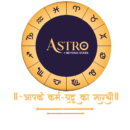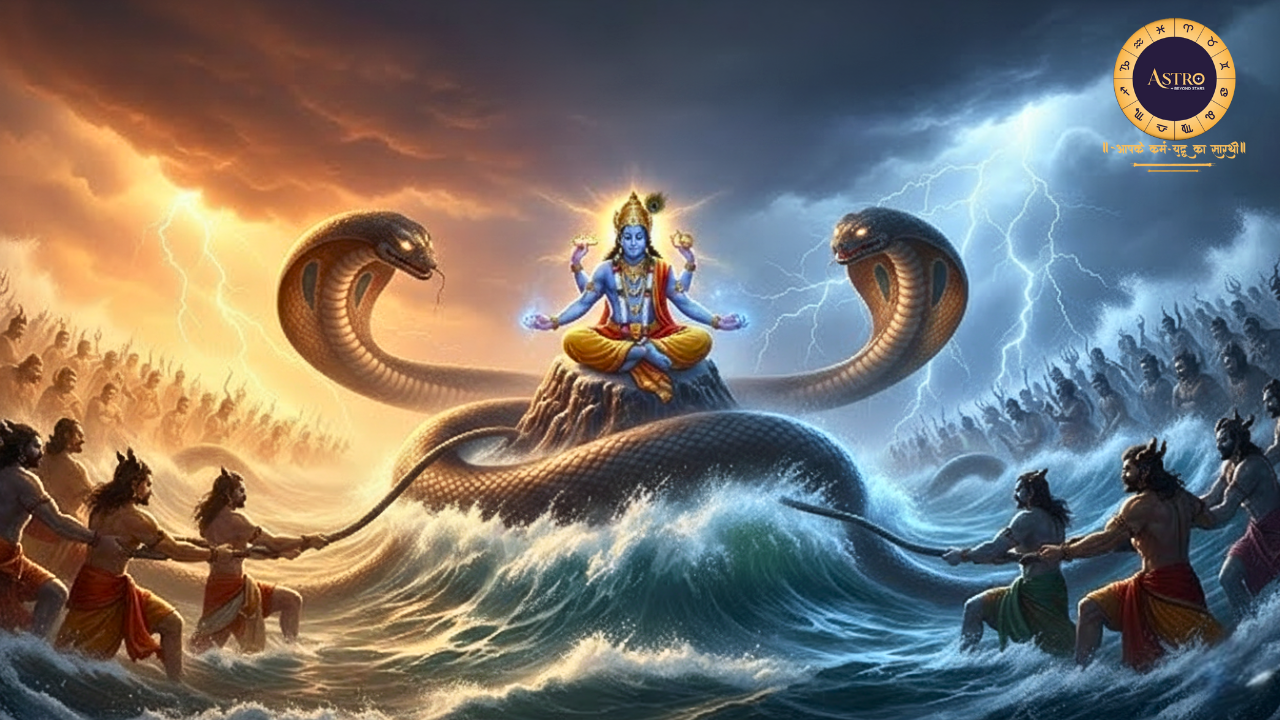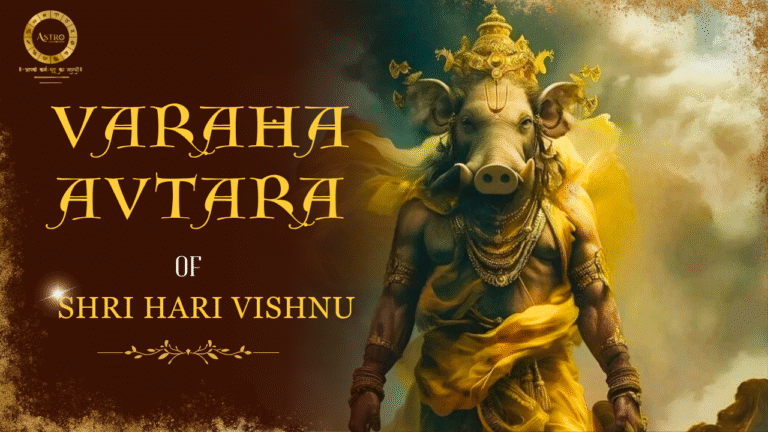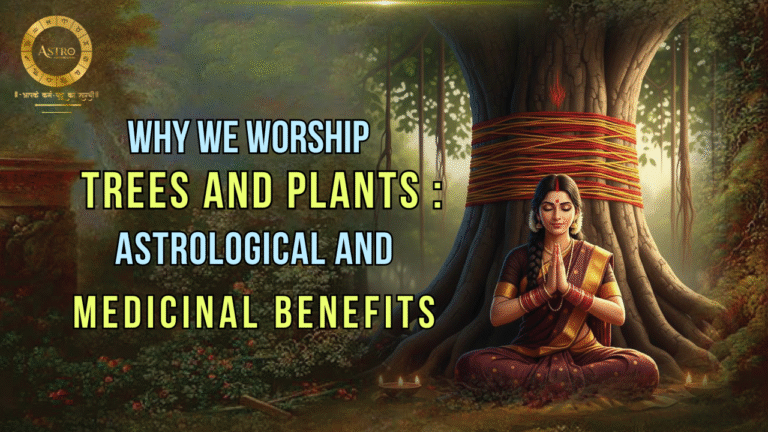The Samudra Manthan, also known as the Churning of the Ocean of Milk, is a significant narrative in Hindu mythology, primarily recounted in the Bhagavata Purana, Vishnu Purana, and Mahabharata. This episode represents the perpetual conflict between good (Devas) and evil (Asuras) and the quest for divine treasures.
The Narrative of Samudra Manthan:
The Devas’ Curse:
Following a curse from the sage Durvasa due to them showing disrespect, the Devas (gods) experienced a loss of power and prosperity. Consequently, the Asuras (demons) began to gain the upper hand, prompting the Devas to seek assistance from Lord Vishnu.
The Scheme for Amrita (Nectar of Immortality):
Lord Vishnu proposed that the Devas and Asuras collaborate to churn the Ksheer Sagar (Ocean of Milk) in order to acquire Amrita, the nectar of immortality, which would restore the Devas’ lost strength.
The Churning Procedure:
Mount Mandara: The Devas and Asuras utilized Mount Mandara as the churning rod.
Vasuki: The serpent Vasuki acted as the churning rope, with the Asuras grasping its head and the Devas holding its tail.
Kurma Avatar: As the mountain began to submerge, Lord Vishnu took the form of Kurma (the tortoise) to provide support by bearing it on his back.
Symbolism of Samudra Manthan:
Cosmic Conflict: The act of churning signifies the on-going battle between righteousness and malevolence.
Collaboration: The Devas and Asuras united in their efforts, illustrating that opposing forces can collaborate towards a common objective.
Spiritual Enlightenment: The treasures obtained represent the fruits of diligent endeavor and the pursuit of spiritual knowledge.
Lord Shiva’s Altruism: His ingestion of Halahala underscores the theme of self-sacrifice for the benefit of others.
Here’s a complete list of the treasures (Ratnas) that emerged from the Samudra Manthan (Churning of the Ocean):
1- Halahala(Poison)
A deadly poison that emerged first, capable of destroying the universe. Lord Shiva consumed it to protect creation, and his throat turned blue, earning him the name Neelkantha.
In a spiritual context, Halahala is often interpreted as the negativity and toxicities of life—anger, greed, jealousy, and hatred. The story of Lord Shiva consuming it serves as a metaphor for how individuals must confront and manage these emotions to achieve inner peace and balance.This act of Shiva is one of the most celebrated aspects of his role as the Mahadeva (Great God) and protector of the universe.
2. Chandra(Moon)
The celestial moon, which was adorned on Lord Shiva’s head as an ornament. Chandra, the Moon, plays a significant role in Hindu mythology and is considered one of the treasures that emerged during the Samudra Manthan (Churning of the Ocean of Milk). It holds deep symbolic and spiritual significance in Hindu cosmology.
· During the churning of the ocean by the Devas (gods) and Asuras (demons), Chandra, the luminous Moon, emerged as one of the divine Ratnas (treasures).
· Lord Shiva’s Adornment: Chandra was accepted by Lord Shiva, who adorned it on his matted hair (jata) as an ornament. This further enhanced Shiva’s iconic form, earning him the title Chandrashekhara (the one who wears the moon on his head).
· The Moon’s association with Shiva signifies calmness, control over time, and a soothing influence.
3-Kalpavriksha
The divine, wish-fulfilling tree, taken to Indraloka, believed to grant wishes. Kalpavriksha , also known as the Wish-Fulfilling Tree, is a legendary divine tree in Hindu, Buddhist, and Jain cosmology. It is one of the treasures (Ratnas) that emerged during the Samudra Manthan (Churning of the Ocean of Milk). The tree is said to have the power to grant any wish or desire and symbolizes abundance, prosperity, and divine blessings.
During the cosmic churning of the ocean by the Devas (gods) and Asuras (demons), Kalpavriksha emerged as one of the celestial treasures.The tree was claimed by Indra, the king of the gods, and planted in his celestial abode, Amaravati, where it provided endless bounty and fulfillment of desires.
4-Kamadhenu
The divine cow that grants all desires. It was given to the sages for performing yajnas (sacrifices). Kamadhenu , often referred to as the Wish-Fulfilling Cow, is a divine bovine goddess in Hindu mythology. She is revered as the source of all prosperity, abundance, and nourishment. Kamadhenu is considered the mother of all cows and a symbol of fertility, selflessness, and divine grace. After her emergence, Kamadhenu was given to the sages and rishis to assist them in performing yajnas (sacrificial rituals). Her milk was used to create ghee, an essential offering in Vedic rituals.
5.Airavata
A majestic, white, four-tusked elephant, taken by Lord Indra as his mount. Airavata, is a divine white elephant in Hindu mythology, revered as the king of elephants and the vehicle (vahana) of Indra, the king of the gods. Airavata holds a prominent place in Hindu cosmology and is also associated with strength, purity, and rainfall. The celestial elephant was claimed by Indra, the king of the gods, to serve as his mount and a symbol of his authority and power.
6. Uchchaihshravas
A seven-headed divine horse, also taken by Lord Indra. Uchchaihshravas, is the divine seven-headed horse in Hindu mythology. It is considered the king of horses (Ashvaraja) Uchchaihshravas is symbolic of speed, strength, grace, and royalty.
7. Kaustubha Mani
A radiant jewel, considered the most precious in the universe, which was taken by Lord Vishnu and worn on his chest. Kaustubha Mani, is a legendary and highly revered divine jewel in Hindu mythology. Kaustubha Mani is regarded as the most radiant and precious gem, symbolizing divinity, purity, and eternal light.
8. Parijat Tree
A celestial flowering tree, which was taken to Indraloka and is said to bloom with fragrant flowers. Parijat, also known as the Night-Flowering Jasmine or Coral Jasmine, is a celestial, wish-fulfilling tree in Hindu mythology. It holds immense spiritual and mythological significance. The Parijat tree was taken to Indraloka (the celestial abode of Indra), where it was planted in the heavenly gardens of Nandanavana. It became a symbol of divinity, prosperity, and eternal beauty.
9. Sharanga Bow
A powerful celestial bow, later associated with Lord Vishnu. Sharanga, is a divine and legendary bow in Hindu mythology, most famously associated with Lord Vishnu. It is regarded as one of his primary weapons and is often depicted in various sacred texts and iconography. Sharanga is not only a symbol of divine power but also represents precision, strength, and the ability to protect righteousness (Dharma).
10. Varuni
The goddess of wine and divine intoxication, accepted by the Asuras. Varuni, is a goddess in Hindu mythology, associated with liquor, fermented beverages, and alcohol. She is considered the goddess of wine and intoxication, and is often depicted as a divine figure that represents the intoxicating, seductive, and blissful powers of alcohol. Claimed by the Devas.
11. Shankha(Conch)
A sacred conch taken by Lord Vishnu, later used as a war trumpet and symbol of auspiciousness. Shankha, also known as the conch shell, holds immense significance in Hindu mythology and is considered one of the most sacred and powerful symbols. The Shankha is an auspicious item that plays an essential role in religious rituals, prayers, and ceremonies. It is especially associated with Lord Vishnu and is often depicted in the hands of various deities, signifying divine power, protection, and the spread of good fortune.
12. Amrita(Nectar of Immortality)
The ultimate treasure, the nectar of immortality, fiercely fought over by the Devas and Asuras, eventually distributed to the Devas by Lord Vishnu in his Mohini avatar. Amrita is a Sanskrit word that means “immortal” or “nectar of immortality.” In Hindu mythology, Amrita is a divine, elixir-like substance that grants immortality and eternal life to those who drink it. It is one of the most important and sought-after treasures in Hindu mythological texts, especially in the context of the Samudra Manthan, where it played a central role.
13- Dhanvantari
The divine physician who emerged holding the pot of Amrita and is considered the origin of Ayurveda. Dhanvantari is a revered figure in Hindu mythology, known as the God of Medicine and the Divine Healer. He is associated with Ayurveda, the traditional system of medicine, and is believed to have brought the knowledge of healing to humanity, and regarded as the one who introduced the healing sciences to the world.
14-Rambha
An apsara (celestial maiden), who became a symbol of beauty and grace. Rambh, associated with several figures in Hindu mythology, particularly known as a celestial nymph or Apsara. In various mythological texts, Rambha is described as one of the most beautiful and influential Apsaras who resides in Indraloka
15-Apsaras
A group of celestial maidens, including other enchanting dancers, who went to Indraloka to entertain the gods.
16-Shri Lakshmi
The goddess of wealth, fortune, and prosperity, who chose to marry Lord Vishnu during her emergence from the churning. Shri Lakshmi, is one of the most widely revered deities in Hinduism, representing wealth, prosperity, fortune, beauty, and abundance. She is often depicted as a goddess of material and spiritual wealth and is considered the divine consort of Lord Vishnu, the preserver of the universe.
The event of Samudra Manthan symbolizes the cosmic struggle between the good (Devas) and the evil (Asuras), culminating in the emergence of divine treasures and lessons for humanity.




